Department of Electrochemistry at the Centenary
Pages of history
 "The true nature of electricity cannot be understood without chemical knowledge" - these are the words of famous M.V. Lomonosov who also accomplished certain very significant observations and drew conclusions on the nature of metal passivity. Due to both the authority of M.V. Lomonosov and the general situation in science, electrochemical studies always played an important role at Moscow University and, moreover, turned out to be very fruitful. Thus in 1807 a member of the Russian Academy of Sciences F.F. Reiss discovered the phenomena of electroosmosis and electrophoresis. The studies by Professor of Physics A.P. Sokolov who pioneered the application of alternating current for capacitance measurements were substantially ahead their time (1877).
"The true nature of electricity cannot be understood without chemical knowledge" - these are the words of famous M.V. Lomonosov who also accomplished certain very significant observations and drew conclusions on the nature of metal passivity. Due to both the authority of M.V. Lomonosov and the general situation in science, electrochemical studies always played an important role at Moscow University and, moreover, turned out to be very fruitful. Thus in 1807 a member of the Russian Academy of Sciences F.F. Reiss discovered the phenomena of electroosmosis and electrophoresis. The studies by Professor of Physics A.P. Sokolov who pioneered the application of alternating current for capacitance measurements were substantially ahead their time (1877).
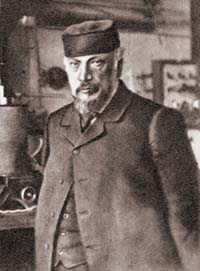
I.A. Kablukov |
 A fundamental contribution to the theory of solutions was made by Professor I.A. Kablukov who proposed the ways to integrating the Mendeleev hydrate theory of solutions and the Arrhenius theory of electrolytic dissociation, based on a concept of dissociation as the interaction with the solvent. Kablukov studied the properties of nonaqueous solutions and discovered the phenomenon of anomalous conductivity. As the author of a famous textbook on physical chemistry and electrochemistry (the first edition in 1902), Kablukov far advanced the popularity of electrochemical science in our country. He was aware that "without knowledge in electrochemistry, it is impossible to solve many problems not only in mineral but also in organic chemistry; the laws of electrochemistry form the basis of many experimental methods for studying various problems of chemical mechanics…"
A fundamental contribution to the theory of solutions was made by Professor I.A. Kablukov who proposed the ways to integrating the Mendeleev hydrate theory of solutions and the Arrhenius theory of electrolytic dissociation, based on a concept of dissociation as the interaction with the solvent. Kablukov studied the properties of nonaqueous solutions and discovered the phenomenon of anomalous conductivity. As the author of a famous textbook on physical chemistry and electrochemistry (the first edition in 1902), Kablukov far advanced the popularity of electrochemical science in our country. He was aware that "without knowledge in electrochemistry, it is impossible to solve many problems not only in mineral but also in organic chemistry; the laws of electrochemistry form the basis of many experimental methods for studying various problems of chemical mechanics…"
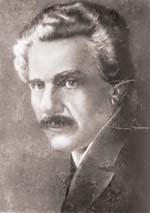
E.I.Shpital'skii |
 In 1911, E.I. Shpital'skii discovered the phenomenon of electropolishing of metals, which was studied later by scientists and students of the Laboratory of Physical Chemistry under his supervision. Concurrently, other problems of theoretical and engineering chemistry were investigated (electrochemical synthesis of Berthollet's salt, studies on chlorine electrolysis, elaboration of new electrochemical methods for synthesizing lead monoxide and copper oxide, etc.). These researches proceeded with participation of N.N. Petin, Z.A. Iofa, A.V. Komandin, V.V. Monblanova, et al. Professor Shpital'skii also organized the studies of hydrogen and oxygen evolution on platinum electrodes by means of a specially developed commutator method. The effect of anodic and cathodic pretreatment on the catalytic activity of platinum and palladium towards hydrogen peroxide decomposition was studied (M.Ya. Kagan).
In 1911, E.I. Shpital'skii discovered the phenomenon of electropolishing of metals, which was studied later by scientists and students of the Laboratory of Physical Chemistry under his supervision. Concurrently, other problems of theoretical and engineering chemistry were investigated (electrochemical synthesis of Berthollet's salt, studies on chlorine electrolysis, elaboration of new electrochemical methods for synthesizing lead monoxide and copper oxide, etc.). These researches proceeded with participation of N.N. Petin, Z.A. Iofa, A.V. Komandin, V.V. Monblanova, et al. Professor Shpital'skii also organized the studies of hydrogen and oxygen evolution on platinum electrodes by means of a specially developed commutator method. The effect of anodic and cathodic pretreatment on the catalytic activity of platinum and palladium towards hydrogen peroxide decomposition was studied (M.Ya. Kagan).
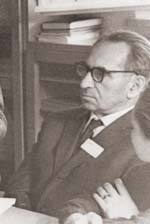
Z.A. Iofa |
 In 1929, E.I. Shpital'skii became a corresponding member of the Academy of Sciences of the USSR and in the same year his scientific activity was abruptly interrupted when he was condemned as a member of the "Prompartiya" organization.
In 1929, E.I. Shpital'skii became a corresponding member of the Academy of Sciences of the USSR and in the same year his scientific activity was abruptly interrupted when he was condemned as a member of the "Prompartiya" organization.
 Among the later studies carried out after the foundation of the Department of Physical Chemistry in 1929, those by N.I. Kobozev and N.I. Nekrasov on the mechanism of electrolytic evolution of hydrogen on metals deserve mention (1930). These authors for the first time recognized the role played in this process by the binding energy of adsorbed hydrogen atoms with metals. N.I. Kobozev and V.V. Monblanova pioneered the use of electrochemical cells separated by palladium membranes for studying the diffusion of hydrogen atoms through palladium.
Among the later studies carried out after the foundation of the Department of Physical Chemistry in 1929, those by N.I. Kobozev and N.I. Nekrasov on the mechanism of electrolytic evolution of hydrogen on metals deserve mention (1930). These authors for the first time recognized the role played in this process by the binding energy of adsorbed hydrogen atoms with metals. N.I. Kobozev and V.V. Monblanova pioneered the use of electrochemical cells separated by palladium membranes for studying the diffusion of hydrogen atoms through palladium.
 When analyzing the effect of the metal nature on the kinetics of electrochemical hydrogen evolution, Kobozev and Monblanova introduced a concept of eletrocatalysis as a phenomenon of acceleration of electrode reactions as a result of adsorption interactions between reactant or intermediate and the electrode metal.
When analyzing the effect of the metal nature on the kinetics of electrochemical hydrogen evolution, Kobozev and Monblanova introduced a concept of eletrocatalysis as a phenomenon of acceleration of electrode reactions as a result of adsorption interactions between reactant or intermediate and the electrode metal.
 Thus, to the beginning of the 30s, active electrochemical studies were already carried out at the Department of Physical Chemistry, which resulted in the institution of the specialization in electrochemistry.
Thus, to the beginning of the 30s, active electrochemical studies were already carried out at the Department of Physical Chemistry, which resulted in the institution of the specialization in electrochemistry.
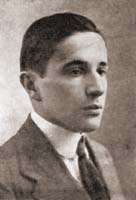
Young A.N.Frumkin |
 In 1930, A.N Frumkin (1895-1976) became the head of the Laboratory of Engineering Electrochemistry at Moscow State University. He was the author of fundamental an theoretical studies on equilibrium properties of charged interfaces, a brilliantly educated scientist of the world level whose studies rated among those of Nernst, Lippmann, Langmuir, despite his youth. In 1932, he was elected a full member of the Academy of Sciences of the USSR. In 1933 the Laboratory of Engineering Electrochemistry headed by A.N. Frumkin was reorganized into the Department of Electrochemistry. During this period, the closest co-workers of A.N. Frumkin were Z.A. Iofa and A.I. Shlygin whose research was already associated with this subject during their previous work at the Department of Physical Chemistry. Academician A.N. Frumkin was the chairman of the Department of Electrochemistry till 1976; since 1976 to 1998, the head of the department was Professor B.B. Damaskin; from November 1998, Professor O.A. Petrii became the chairman of this department.
In 1930, A.N Frumkin (1895-1976) became the head of the Laboratory of Engineering Electrochemistry at Moscow State University. He was the author of fundamental an theoretical studies on equilibrium properties of charged interfaces, a brilliantly educated scientist of the world level whose studies rated among those of Nernst, Lippmann, Langmuir, despite his youth. In 1932, he was elected a full member of the Academy of Sciences of the USSR. In 1933 the Laboratory of Engineering Electrochemistry headed by A.N. Frumkin was reorganized into the Department of Electrochemistry. During this period, the closest co-workers of A.N. Frumkin were Z.A. Iofa and A.I. Shlygin whose research was already associated with this subject during their previous work at the Department of Physical Chemistry. Academician A.N. Frumkin was the chairman of the Department of Electrochemistry till 1976; since 1976 to 1998, the head of the department was Professor B.B. Damaskin; from November 1998, Professor O.A. Petrii became the chairman of this department.
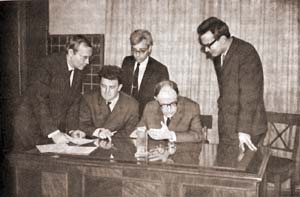
A.N.Frumkin with colleague (1967) |
 The directions of scientific studies at the Department of Electrochemistry were largely predetermined immediately in 1930 with the appearance of a famous paper by A.N. Frumkin, in which the electrode process rate was related for the first time to the structure of the electrode-solution interface. Actually, this work heralded the birth of a new direction of electrochemistry - kinetics of the elementary act of electron transfer, the central problem of the kinetics of electrode processes. To verify the slow discharge theory, it was necessary to stage principally new studies, substantially improve measuring techniques, and obtain precision data on the dependence of the rate of electrochemical hydrogen evolution on the electrode potential and solution composition. Such studies were carried out on mercury and lead electrodes (Z.A. Iofa, V.S. Bagotzky, O.L. Kaptsan, N.V. Nikolaeva, E.P. Andreeva, et al.) and contributed to the recognition of the Frumkin theory of slow discharge, since occupying the strong position in electrochemical science.
The directions of scientific studies at the Department of Electrochemistry were largely predetermined immediately in 1930 with the appearance of a famous paper by A.N. Frumkin, in which the electrode process rate was related for the first time to the structure of the electrode-solution interface. Actually, this work heralded the birth of a new direction of electrochemistry - kinetics of the elementary act of electron transfer, the central problem of the kinetics of electrode processes. To verify the slow discharge theory, it was necessary to stage principally new studies, substantially improve measuring techniques, and obtain precision data on the dependence of the rate of electrochemical hydrogen evolution on the electrode potential and solution composition. Such studies were carried out on mercury and lead electrodes (Z.A. Iofa, V.S. Bagotzky, O.L. Kaptsan, N.V. Nikolaeva, E.P. Andreeva, et al.) and contributed to the recognition of the Frumkin theory of slow discharge, since occupying the strong position in electrochemical science.
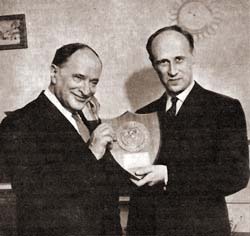
A.N.Frumkin and J. O'M. Bokris (1960) |
 The dependence between the electrode process kinetics and the potential distribution near the electrode surface manifests itself during electroreduction of anions on negatively charged electrode surfaces, which was first recognized by A.N. Frumkin and G.M. Florianovich. For a cathodic (reduction) process, the potential shift to the negative direction usually results in acceleration of the reaction (an increase in the cathodic current density). However, when anions are reduced from dilute solutions, the potential shift in a certain potential range is accompanied first by a current drop usually followed by its rise.
The dependence between the electrode process kinetics and the potential distribution near the electrode surface manifests itself during electroreduction of anions on negatively charged electrode surfaces, which was first recognized by A.N. Frumkin and G.M. Florianovich. For a cathodic (reduction) process, the potential shift to the negative direction usually results in acceleration of the reaction (an increase in the cathodic current density). However, when anions are reduced from dilute solutions, the potential shift in a certain potential range is accompanied first by a current drop usually followed by its rise.
 A comprehensive study of this phenomenon (N.V. Fedorovich, B.B. Damaskin, O.A. Petrii, E.V. Stenina, et al.) has introduced many principally novel ideas to the theory of electrode processes and new concepts of the interface structure.
A comprehensive study of this phenomenon (N.V. Fedorovich, B.B. Damaskin, O.A. Petrii, E.V. Stenina, et al.) has introduced many principally novel ideas to the theory of electrode processes and new concepts of the interface structure.
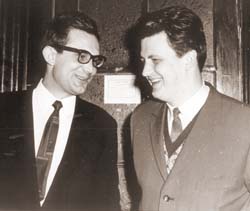
O.A.Petrii and B.B.Damaskin |
 In parallel with works on the kinetics of electrode processes, active studies of the structure of the electrode-solution interface were carried out (this interface is often called the "electrical double layer"). The most important result of these works is the development by B.B. Damaskin of a quantitative theory of reversible adsorption of ions and organic compounds on electrodes. Currently, the analysis of this phenomenon involves the use of modern computation and simulation techniques. A phenomenon of the formation of condensed layers of organic compounds on electrodes - a special case of self-organization on interfaces - is studied in detail (E.V. Stenina). A newly discovered phenomenon associated with the changes, which occur in the surface composition upon its renewal by cutting immediately under a solution layer, is studied (V.A. Safonov). In this case, electrochemical techniques provide information valuable for quantitative investigation of certain complex physical phenomena such as surface diffusion, surface restructuring of grains and intergrain boundaries. These methods allow one indirectly analyze the surface composition. All these studies are aimed at solving the problems of electrochemical kinetics, making it possible to refine the structure of the reaction layer.
In parallel with works on the kinetics of electrode processes, active studies of the structure of the electrode-solution interface were carried out (this interface is often called the "electrical double layer"). The most important result of these works is the development by B.B. Damaskin of a quantitative theory of reversible adsorption of ions and organic compounds on electrodes. Currently, the analysis of this phenomenon involves the use of modern computation and simulation techniques. A phenomenon of the formation of condensed layers of organic compounds on electrodes - a special case of self-organization on interfaces - is studied in detail (E.V. Stenina). A newly discovered phenomenon associated with the changes, which occur in the surface composition upon its renewal by cutting immediately under a solution layer, is studied (V.A. Safonov). In this case, electrochemical techniques provide information valuable for quantitative investigation of certain complex physical phenomena such as surface diffusion, surface restructuring of grains and intergrain boundaries. These methods allow one indirectly analyze the surface composition. All these studies are aimed at solving the problems of electrochemical kinetics, making it possible to refine the structure of the reaction layer.
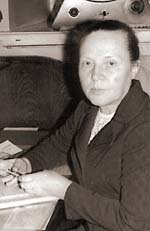
N.V. Fedorovich |
 At present, the development of the slow discharge theory at the Department of Electrochemistry has entered a new phase. Attempts are undertaken to take into account the reactant structure and the true charge distribution in the reaction layer, theoretically estimate the activation energy of the process, characterize quantitatively the role played in the electrode process by the formation of ion pairs in the solution bulk and on the surface, take into account some other physically significant effects. Such a progress in the studies on electrochemical kinetics became possible due to the developments of quantum chemistry and the use of modern simulation techniques (G.A. Tsirlina, O.A. Petrii, in collaboration with R.R.Nazmutdinov). Aimed at experimental checking of new concepts of electrochemical kinetics, a study on the reduction of heteropolycompounds, which involves the long range electron transfer strictly determined by the reactant geometry, has been started.
At present, the development of the slow discharge theory at the Department of Electrochemistry has entered a new phase. Attempts are undertaken to take into account the reactant structure and the true charge distribution in the reaction layer, theoretically estimate the activation energy of the process, characterize quantitatively the role played in the electrode process by the formation of ion pairs in the solution bulk and on the surface, take into account some other physically significant effects. Such a progress in the studies on electrochemical kinetics became possible due to the developments of quantum chemistry and the use of modern simulation techniques (G.A. Tsirlina, O.A. Petrii, in collaboration with R.R.Nazmutdinov). Aimed at experimental checking of new concepts of electrochemical kinetics, a study on the reduction of heteropolycompounds, which involves the long range electron transfer strictly determined by the reactant geometry, has been started.
 Electron tunneling across the electrode-solution interface has common features with the tunneling between a sample and a probe of a scanning tunneling microscope. This is why in 1993 the Department of Electrochemistry initiated studies in the field of scanning tunneling microscopy (STM) and spectroscopy (STS). These studies are aimed at realization of a phenomenon of resonance tunneling by modifying the probe with nanostructures and molecular clusters. Resonance tunneling pertains to fundamental physical phenomena, which form the basis for operation of many microelectronic units. These studies are carried out based on tunneling microscopes made in our country and equipped with special spectroscopic units and original software, with participation of leading Russian physicists (A.M. Dykhne and his school).
Electron tunneling across the electrode-solution interface has common features with the tunneling between a sample and a probe of a scanning tunneling microscope. This is why in 1993 the Department of Electrochemistry initiated studies in the field of scanning tunneling microscopy (STM) and spectroscopy (STS). These studies are aimed at realization of a phenomenon of resonance tunneling by modifying the probe with nanostructures and molecular clusters. Resonance tunneling pertains to fundamental physical phenomena, which form the basis for operation of many microelectronic units. These studies are carried out based on tunneling microscopes made in our country and equipped with special spectroscopic units and original software, with participation of leading Russian physicists (A.M. Dykhne and his school).
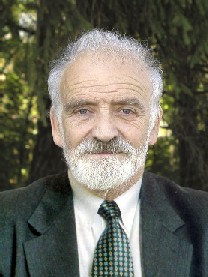
A.M.Dykhne |
 The use of STM for visualization of complex surfaces with nanoscale resolution allowed us to advance the studies in the field of electrocatalysis, which date back to the works by A.N. Frumkin and A.I. Shlygin in 1932-1937 and since formed a major research direction at the Department. These studies made a great contribution to the development of the electrocatalysis theory - elucidation of mechanisms of electrocatalytic processes, revealing the nature of the potential at the electrode/solution interface and refining the electrical double layer structure at interfaces of catalytically active metals (first of all, platinum-group metals and their alloys) with electrolyte solutions, finding the role of electronic and structural factors in electrocatalysis. The progress in these fields became possible due to the development of new experimental methods (charging curves, adsorption curves, isoelectrical potential shifts, potentiometric titration under isoelectric conditions, electrooxidation-electroreduction in the adsorption layer). One of most important results is the development of the general theory of electrocapillarity (A.N. Frumkin, O.A. Petrii), which can be applied to various electrode types including those capable of reversible adsorption of hydrogen and oxygen accompanied by charge transfer and, moreover, involves a joint consideration of co-adsorption of ions an atoms.
The use of STM for visualization of complex surfaces with nanoscale resolution allowed us to advance the studies in the field of electrocatalysis, which date back to the works by A.N. Frumkin and A.I. Shlygin in 1932-1937 and since formed a major research direction at the Department. These studies made a great contribution to the development of the electrocatalysis theory - elucidation of mechanisms of electrocatalytic processes, revealing the nature of the potential at the electrode/solution interface and refining the electrical double layer structure at interfaces of catalytically active metals (first of all, platinum-group metals and their alloys) with electrolyte solutions, finding the role of electronic and structural factors in electrocatalysis. The progress in these fields became possible due to the development of new experimental methods (charging curves, adsorption curves, isoelectrical potential shifts, potentiometric titration under isoelectric conditions, electrooxidation-electroreduction in the adsorption layer). One of most important results is the development of the general theory of electrocapillarity (A.N. Frumkin, O.A. Petrii), which can be applied to various electrode types including those capable of reversible adsorption of hydrogen and oxygen accompanied by charge transfer and, moreover, involves a joint consideration of co-adsorption of ions an atoms.
 At present, the studies of electrocatalysis are focused on the problem of new electrocatalytic materials, which include intermetallic compounds capable of sorbing great amounts of hydrogen. Such materials can be applied in nickel-metal-hydride batteries, i.e., environmentally clean power sources of wide application. Their properties as the catalysts of electrohydrogenation processes might be of no less interest. Palladium electrode is used as a model system in these studies. Based on palladium membrane electrodes, one can realize the so-called membrane electrocatalysis, i.e., regulate the reaction-layer composition by controlling the delivery and removal of hydrogen through a membrane.
At present, the studies of electrocatalysis are focused on the problem of new electrocatalytic materials, which include intermetallic compounds capable of sorbing great amounts of hydrogen. Such materials can be applied in nickel-metal-hydride batteries, i.e., environmentally clean power sources of wide application. Their properties as the catalysts of electrohydrogenation processes might be of no less interest. Palladium electrode is used as a model system in these studies. Based on palladium membrane electrodes, one can realize the so-called membrane electrocatalysis, i.e., regulate the reaction-layer composition by controlling the delivery and removal of hydrogen through a membrane.
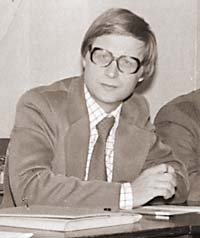
B.I.Podlovchenko |
 However, the most important direction in the field of electrocatalysis is associated with the studies of properties of nanosize particles as well with the development of methods for their synthesis and stabilization. Such particles can be formed on various supports by different methods or incorporated into polymeric matrices. Electrochemical methods (anodic polarization) allow not only synthesizing such matrices of conducting polymers (e.g., polyaniline) but also incorporating small metal particles into them immediately during their preparation. This is a way of solving the problem of stabilization of nanoparticles, although certain factors associated with the particle-matrix interaction can affect the electrocatalytic properties (B.I. Podlovchenko et al.).
However, the most important direction in the field of electrocatalysis is associated with the studies of properties of nanosize particles as well with the development of methods for their synthesis and stabilization. Such particles can be formed on various supports by different methods or incorporated into polymeric matrices. Electrochemical methods (anodic polarization) allow not only synthesizing such matrices of conducting polymers (e.g., polyaniline) but also incorporating small metal particles into them immediately during their preparation. This is a way of solving the problem of stabilization of nanoparticles, although certain factors associated with the particle-matrix interaction can affect the electrocatalytic properties (B.I. Podlovchenko et al.).
 Electrocatalytic properties of nanoparticles are studied by the example of a number of model processes (electrooxidation of organic substances and carbon monoxide, electrohydrohenation of carbon dioxide, electroreduction of nitrocompounds).
Electrocatalytic properties of nanoparticles are studied by the example of a number of model processes (electrooxidation of organic substances and carbon monoxide, electrohydrohenation of carbon dioxide, electroreduction of nitrocompounds).
 Systematic studies of corrosion processes date back to the 40s and were associated with accomplishing certain important applied works (Z.A. Iofa, M.A. Gerovich, R.I. Kaganovich, et al.). Later, a number of valuable fundamental results were obtained in this field: elucidation of the mechanism of action of corrosion inhibitors (V.A. Kuznetsov), revealing the mechanism of the effect of halide salts on the metal dissolution, and assessments of the effectiveness of inhibitor action on the hydrogen embrittlement of iron and steels.
Systematic studies of corrosion processes date back to the 40s and were associated with accomplishing certain important applied works (Z.A. Iofa, M.A. Gerovich, R.I. Kaganovich, et al.). Later, a number of valuable fundamental results were obtained in this field: elucidation of the mechanism of action of corrosion inhibitors (V.A. Kuznetsov), revealing the mechanism of the effect of halide salts on the metal dissolution, and assessments of the effectiveness of inhibitor action on the hydrogen embrittlement of iron and steels.
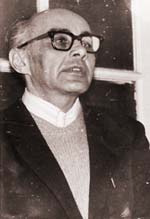
V.N. Korshunov |
 It was shown that corrosion processes occur not only via the electrochemical mechanism when conjugated reactions of metal ionization and hydrogen evolution (or oxygen reduction) proceed on different centers, but also via a chemical mechanism, i.e., in a single act (V.N. Korshunov). A relationship between the metal dissolution rate and the composition of water-organic solutions was demonstrated (V.A. Safonov).
It was shown that corrosion processes occur not only via the electrochemical mechanism when conjugated reactions of metal ionization and hydrogen evolution (or oxygen reduction) proceed on different centers, but also via a chemical mechanism, i.e., in a single act (V.N. Korshunov). A relationship between the metal dissolution rate and the composition of water-organic solutions was demonstrated (V.A. Safonov).

V.A. Safonov |
 Finally, a new method for studying multistage electrode processes -the method of rotating ring-disk electrode, which was developed at the Department of Electrochemistry in the late 50s (A.N. Frumkin, L.N. Nekrasov), deserves mention. This method allows registering intermediate (including short-lived) products formed on a disk electrode by recording the current of their electrochemical reactions on a closely located independent ring electrode. This method was applied especially widely and successfully in electrochemistry of organic substances, it also provided valuable information on the kinetics of the reaction of oxygen reduction - the process most important for practice.
Finally, a new method for studying multistage electrode processes -the method of rotating ring-disk electrode, which was developed at the Department of Electrochemistry in the late 50s (A.N. Frumkin, L.N. Nekrasov), deserves mention. This method allows registering intermediate (including short-lived) products formed on a disk electrode by recording the current of their electrochemical reactions on a closely located independent ring electrode. This method was applied especially widely and successfully in electrochemistry of organic substances, it also provided valuable information on the kinetics of the reaction of oxygen reduction - the process most important for practice.
 Department of Electrochemistry is the leading organization at the Education and Research Center on Physical Chemistry and Chemical Nanotechnology (UNTs "Nanokhimiya"), which was organized in 1997 on the basis of Faculty of Chemistry of Moscow State University and the Institute of Physical Chemistry of the Russian Academy of Sciences. This center also involves Departments of Physical and Colloid Chemistry.
Department of Electrochemistry is the leading organization at the Education and Research Center on Physical Chemistry and Chemical Nanotechnology (UNTs "Nanokhimiya"), which was organized in 1997 on the basis of Faculty of Chemistry of Moscow State University and the Institute of Physical Chemistry of the Russian Academy of Sciences. This center also involves Departments of Physical and Colloid Chemistry.
 The Department organizes annual Frumkin Readings and Readings in Memory of N.A. Bakh.
The Department organizes annual Frumkin Readings and Readings in Memory of N.A. Bakh.
 Since the foundation of the Department of Electrochemistry, nearly 400 graduate and post-graduate students were trained for Russia and other countries of the former USSR, and also 90 graduate and post-graduate students and trainers from 23 countries: Bulgaria, Hungary, Vietnam, German Democratic Republic, China, Cuba, Poland, Rumania, Czechoslovakia, Yugoslavia, Algeria, Guinea, Egypt, India, Iraq, Canada, Columbia, Mexico, Syria, USA, France, Ecuador, and Japan. There are close contacts in the field of pedagogical activities with the Warsaw University, Russian University of People Friendship, and a number of other universities of Russia.
Since the foundation of the Department of Electrochemistry, nearly 400 graduate and post-graduate students were trained for Russia and other countries of the former USSR, and also 90 graduate and post-graduate students and trainers from 23 countries: Bulgaria, Hungary, Vietnam, German Democratic Republic, China, Cuba, Poland, Rumania, Czechoslovakia, Yugoslavia, Algeria, Guinea, Egypt, India, Iraq, Canada, Columbia, Mexico, Syria, USA, France, Ecuador, and Japan. There are close contacts in the field of pedagogical activities with the Warsaw University, Russian University of People Friendship, and a number of other universities of Russia.
 The course of lectures on electrochemistry read for many years by A.N. Frumkin formed the basis for the world-first study-book on the kinetics of electrode processes, which was edited in 1952 by the Moscow State University Publishing House.
The course of lectures on electrochemistry read for many years by A.N. Frumkin formed the basis for the world-first study-book on the kinetics of electrode processes, which was edited in 1952 by the Moscow State University Publishing House.
 A monograph "Adsorption of Organic Compounds on Electrodes" played an important role in the development of studies on adsorption of organic compounds. This book was translated into English and German.
A monograph "Adsorption of Organic Compounds on Electrodes" played an important role in the development of studies on adsorption of organic compounds. This book was translated into English and German.
 A number of original Frumkin's papers are available here, as well as the pioneering papers on Pt-Ru electrochemistry (mid 60th) and recent original papers published by the members of the Department.
A number of original Frumkin's papers are available here, as well as the pioneering papers on Pt-Ru electrochemistry (mid 60th) and recent original papers published by the members of the Department.
REFERENCES
- A.N.Frumkin, Z. physik. Chem., 1933, Bd.164, S.121.
- A.N. Frumkin, V.S. Bagotzky, Z.A. Iofa, and B.N. Kabanov, Kinetics of Electrode Processes, Moscow: Vyssh. Shkola, 1952.
- B.B. Damaskin, O.A. Petrii, V.V. Batrakov, Adsorption of Organic Compounds on Electrodes, Moscow: Nauka, 1968.
 Back
Back
![]() "The true nature of electricity cannot be understood without chemical knowledge" - these are the words of famous M.V. Lomonosov who also accomplished certain very significant observations and drew conclusions on the nature of metal passivity. Due to both the authority of M.V. Lomonosov and the general situation in science, electrochemical studies always played an important role at Moscow University and, moreover, turned out to be very fruitful. Thus in 1807 a member of the Russian Academy of Sciences F.F. Reiss discovered the phenomena of electroosmosis and electrophoresis. The studies by Professor of Physics A.P. Sokolov who pioneered the application of alternating current for capacitance measurements were substantially ahead their time (1877).
"The true nature of electricity cannot be understood without chemical knowledge" - these are the words of famous M.V. Lomonosov who also accomplished certain very significant observations and drew conclusions on the nature of metal passivity. Due to both the authority of M.V. Lomonosov and the general situation in science, electrochemical studies always played an important role at Moscow University and, moreover, turned out to be very fruitful. Thus in 1807 a member of the Russian Academy of Sciences F.F. Reiss discovered the phenomena of electroosmosis and electrophoresis. The studies by Professor of Physics A.P. Sokolov who pioneered the application of alternating current for capacitance measurements were substantially ahead their time (1877).











